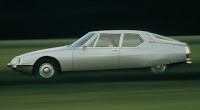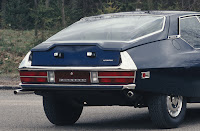
Driven by one of our readers comments -that's you we're talking about 'A Knesal' - in our previous classic car post on the BMW 2002, we decided to take a stroll down memory lane with one of Citroen's most prominent models, the SM. The French GT was unveiled in 1970 at the Geneva Motor Show surprising the press and the public alike with its streamlined and contemporary Gallic aesthetics and its advanced technological features. Add the Maserati-derived V6 engine to the equation and you can get some idea of the expectations that Citroen created with the SM.
 Development of the high-tech coupe began in 1966 by Jacques Né, who wanted to create a sportier version of the iconic DS as well as a model that would be the crown jewel of the French marque's automobile range.
Development of the high-tech coupe began in 1966 by Jacques Né, who wanted to create a sportier version of the iconic DS as well as a model that would be the crown jewel of the French marque's automobile range.The acquisition of Maserati by Citroen in 1968 gave the company's engineers access to the Italian brand's V6 engine which developed an output of 170Hp from a displacement of 2.7-liters. Power was driven to the front-wheels through a five-speed manual gearbox or a three-speed automatic transmission. According to Citroen's books, the manual SM could reach 100km/h (62mph) from standstill in 8,9 seconds and achieve a top speed of 220km/h or 137mph.
Being the range-topping model, the SM inherited the DS's sophisticated hydro pneumatic suspension system with the height adjustment function that made the car not only an exceptional and comfortable cruiser, but also well mannered in terms of handling, especially for a powerful front-wheel drive car of the era.
 The SM also came with numerous other technological features such as its automatic leveling six iodine headlamps that swiveled with the steering, rain-sensing windshield wipers, variable assist steering system, optional lightweight composite wheels that weighed less than half the standard weight and an adjustable in both height and reach steering column -remember, we're talking about 1970.
The SM also came with numerous other technological features such as its automatic leveling six iodine headlamps that swiveled with the steering, rain-sensing windshield wipers, variable assist steering system, optional lightweight composite wheels that weighed less than half the standard weight and an adjustable in both height and reach steering column -remember, we're talking about 1970.And then there's the styling. Citroen -at least in the past- always managed to design cars that looked like nothing else out on the road. Even though the styling focused primarily on aerodynamics achieving Cd (coefficient of aerodynamic drag) of 0.336 or 25% lower than that of the DS, the SM was, and still remains today, one of the most classy and futuristic looking vehicles ever to be produced.
Like most GT cars of the era, the SM also participated in many racing events including numerous rallies across Europe. Race-versions aside, French coachbuilder Henri Chapron also created two presidential, four-door convertible limousine variants of the SM in 1972 that were used for many years by the French governments.
 But as promising as Citroen's four-seater Gran Turismo was when it entered the market in 1970, the coupe proved to be unreliable (especially in concern of the Maserati V6) and rather costly and complicated to fix. Combine this with the oil crisis in the mid 70s along with the fact that Citroen went bankrupt in 1974 and was acquired by Peugeot a year later, and it's easy to see why the GT's life came to an abrupt end in 1975 after selling a total of 12,920 cars.
But as promising as Citroen's four-seater Gran Turismo was when it entered the market in 1970, the coupe proved to be unreliable (especially in concern of the Maserati V6) and rather costly and complicated to fix. Combine this with the oil crisis in the mid 70s along with the fact that Citroen went bankrupt in 1974 and was acquired by Peugeot a year later, and it's easy to see why the GT's life came to an abrupt end in 1975 after selling a total of 12,920 cars.The French automaker announced it was stopping production of the SM in summer 1975, with these words: "The SM was born from speed and died with speed".
Today, the SM is considered as one of the most important and prestigious models in Citroen's long history and one that continues to draw the attention of automotive enthusiasts throughout the world.












